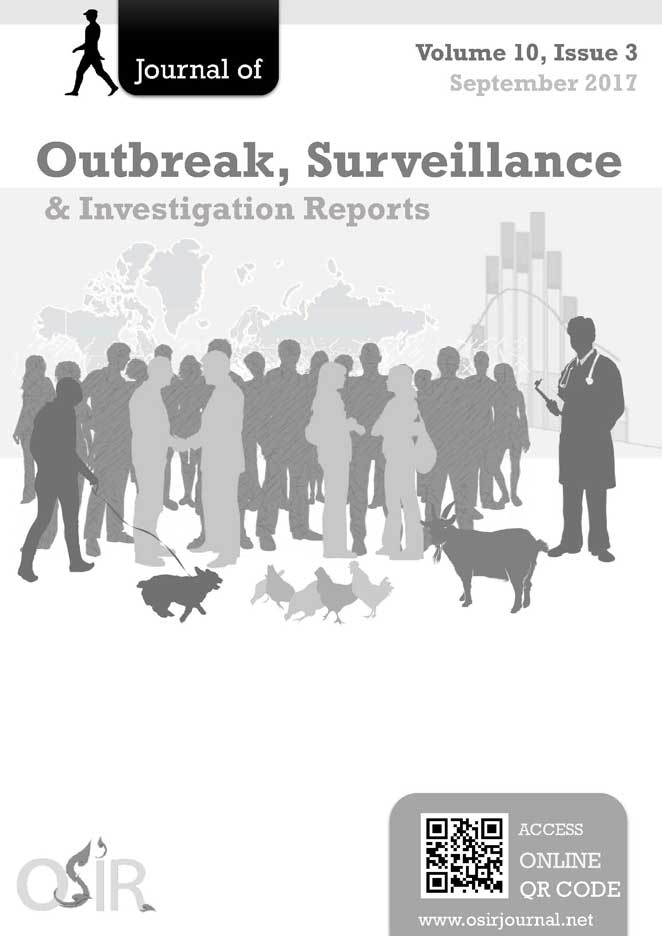Epidemiological Situation of Malaria in Rakhine State, Myanmar during 2000-2014
DOI:
https://doi.org/10.59096/osir.v10i3.263088Keywords:
malaria, morbidity, mortality, case-fatality, Rakhine State, MyanmarAbstract
Rakhine State is the state with highest number of malaria cases in Myanmar. The objective of the study was to investigate the malaria situation in Rakhine State during 2000-2014. Data on malaria monthly reports from all townships during 2000-2014 were reviewed and analyzed. The malaria morbidity rate in Rakhine State was observed to decrease from 40.0 per 1,000 population in 2000 to 13.5 per 1,000 in 2014. Marked reduction in mortality and case-fatality rates were also observed. Although the morbidity and mortality rates were reduced in all townships, some townships had maintained high malaria positivity rate and low annual blood examination rate. Ten percent of cases in under 5-year children indicated the endemicity and local transmission of malaria. Malaria cases treated by community volunteers were increased from 1.7% in 2011 to 27.9% in 2014. The majority of malaria cases were caused by Plasmodium falciparum. Reduction in malaria morbidity and mortality might be due to early detection and treatment of cases. Efforts to detect and treat cases earlier should be a high priority in townships with high malaria positive rate and low annual blood examination rate in order to reduce the burden of malaria infection in Myanmar.
References
Myanmar. Ministry of Health. Health in Myanmar 2014. Nay Pyi Taw: Ministry of Health, Myanmar; 2014.
Myanmar. Vector Borne Disease Control and National Malaria Control Program. Department of Health. Ministry of Health. Annual vector borne disease control report, 2012. Nay Pyi Taw: Ministry of Health, Myanmar; 2013.
Myanmar. Vector Borne Disease Control and National Malaria Control Program. Department of Health. Ministry of Health. Annual vector borne disease control report, 2013. Nay Pyi Taw: Myanmar Ministry of Health; 2014.
Rakhine State Vector Borne Diseases Control Programme, Rakhine State Public Health Department. Vector borne disease control annual reports, 2007-2014. Sittwe: Rakhine State Public Health Department; 2015.
Myanmar. Department of Population. Ministry of Immigration and Population. Rakhine State census report, 2014. Nay Pyi Taw: Myanmar Ministry of Immigration and Population; 2015.
World Health Organization. A framework for malaria eliminating. Geneva: World Health Organization; 2017.
Erhart A, Thang ND, Hung NQ, Toi le V, Hung le X, Tuy TQ, et al. Forest malaria in Vietnam: a challenge for control. Am J Trop Med Hyg. 2004 Feb;70(2):110-8.
Kar NP, Kumar A, Singh OP, Carlton JM, Nanda N. A review of malaria transmission dynamics in forest ecosystems. Parasit Vectors. 2014;7:265.
Myanmar. Department of Public Health. Ministry of Health. National strategic plan for intensifying malaria control and accelerating progress towards malaria elimination 2016-2020. Nay Pyi Taw: Ministry of Health, Myanmar; 2015.
World Health Organization. Guideline for the treatment of malaria. 2nd ed. Geneva: World Health Organization; 2010.
World Health Organization. Community-based reduction of malaria transmission. Geneva: World Health Organization; 2012.
Downloads
Published
How to Cite
Issue
Section
License
Copyright (c) 2023 Outbreak, Surveillance, Investigation & Response (OSIR) Journal

This work is licensed under a Creative Commons Attribution-NonCommercial-NoDerivatives 4.0 International License.









